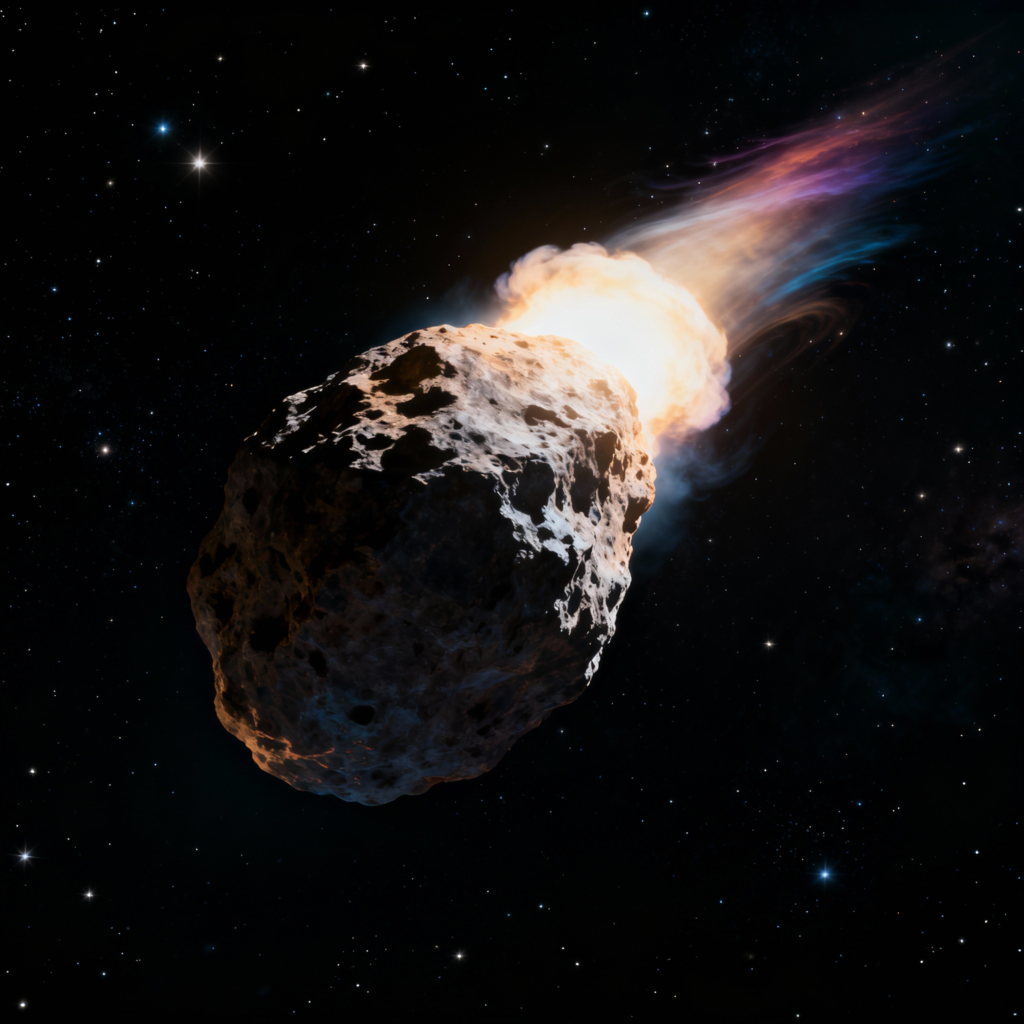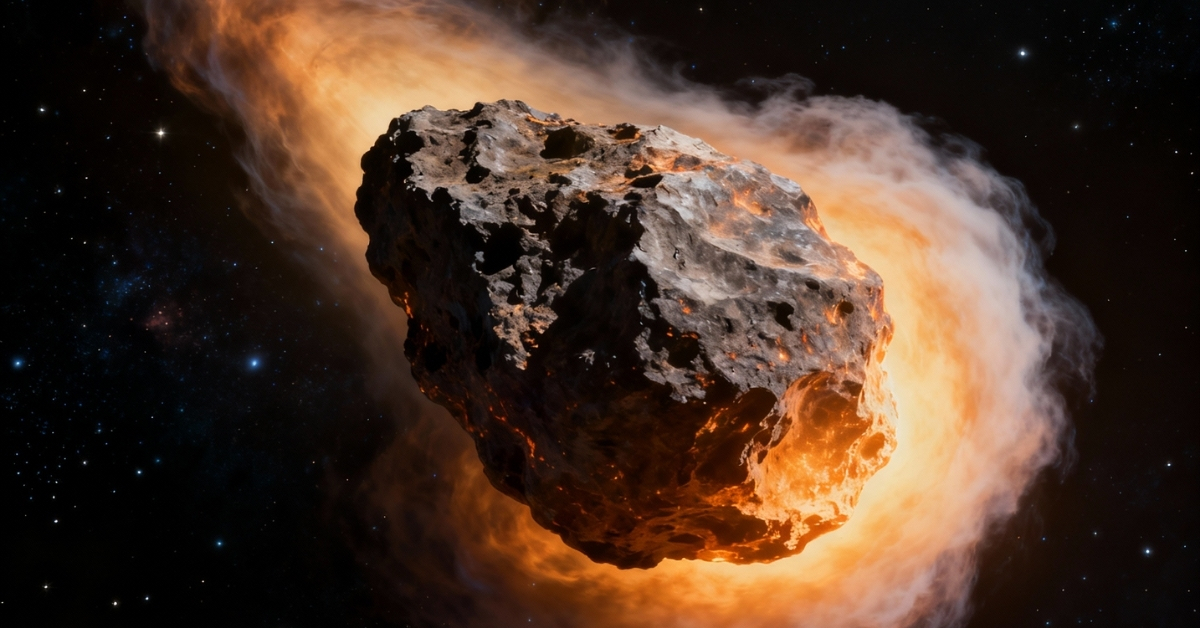In July 2025 astronomers detected a strange new comet on a hyperbolic path through our Solar System. The object is officially named 3I/ATLAS, marking it as the third (3) interstellar (I) object known, discovered by the ATLAS survey telescope in Chile. In other words, 3I/ATLAS is a visitor from beyond the Sun’s family. It follows 1I/’Oumuamua (2017) and 2I/Borisov (2019) as only the third interstellar traveler ever seen by humans. European space officials note that these interstellar comets are “absolutely foreign” – they carry clues from distant star systems rather than sharing our Solar System’s origin.
3I/ATLAS is clearly a comet, not an asteroid or spacecraft. Space telescope images (Hubble, Webb) and ground-based data show it surrounded by a fuzzy coma of gas and dust and even a hint of a tail. At about the size of a small mountain, its icy core likely spans a few hundred meters to a few kilometers. The comet races at an extraordinary speed – on the order of 200,000 km/h (roughly 130,000–210,000 mph) – faster than any comet yet observed in our Solar System. This blistering speed and a strongly hyperbolic trajectory confirm that 3I/ATLAS did not form around our Sun, but came drifting in from interstellar space. Once it swings through the inner system, 3I/ATLAS will slingshot back out into the galaxy and never return.
Quick Facts & Key Data:
- Discovery: Spotted July 1, 2025, by the ATLAS telescope network in Chile. The unusual orbit (not orbiting the Sun) revealed it must be an interstellar comet.
- Name Meaning: “3I” means the 3rd interstellar object ever confirmed, and “ATLAS” is the survey that found it.
- Speed: ~210,000 km/h (fastest known for a comet).
- Size: Roughly 0.3–5.6 km across (nucleus size uncertain).
- Trajectory: Strongly hyperbolic (on a one-time pass). It’s “like a rifle bullet” through the system.
- Age: Billions of years (likely older than our Solar System).
- First Interstellar Comets: Before 3I/ATLAS, only ʻOumuamua and 2I/Borisov were confirmed interstellar visitors. Those three may just be the tip of an iceberg: models suggest thousands of such objects might drift through the Solar System at any time.
Astronomers are excited that 3I/ATLAS offers a rare chance to sample material from another star system up close. In a sense, it is an interstellar case study – a natural experiment. Every planet and comet in our system formed together, so a foreign comet like this carries new chemistry and history. ESA writes that studying 3I/ATLAS could reveal “clues about the formation of worlds far beyond our own”.
Discovery and Trajectory
3I/ATLAS was first detected on July 1, 2025, during routine scans by ATLAS (Asteroid Terrestrial-impact Last Alert System). Immediately, its path stood out. Follow-up observations by astronomers worldwide confirmed it is not bound to the Sun. Instead, it’s on a hyperbolic escape trajectory, confirming an origin from outside our Solar System.
By analyzing the orbit, scientists determined key milestones for the comet’s Solar System flyby:
- Close to Mars (Oct 3, 2025): 3I/ATLAS will pass about 30 million km from Mars. ESA’s Mars Express and ExoMars orbiters, along with NASA’s Mars Reconnaissance Orbiter and others, will use this vantage point to study the comet up-close.
- Perihelion (Oct 29–30, 2025): The comet’s closest approach to the Sun will be about 210 million km (just inside Mars’s orbit). At that point, solar heating will cause its ices to vaporize intensely, powering bright jets and a long tail. This event is effectively the turning point of the encounter.
- Behind the Sun (Late Oct 2025): Soon after perihelion, 3I/ATLAS will slip behind the Sun’s glare from Earth’s view. During this solar conjunction, ground telescopes on Earth cannot see it. However, ESA’s orbital spacecraft (e.g. Jupiter’s JUICE mission) will have a clear line of sight and will observe the comet’s peak activity.
- Closest to Earth (Dec 19, 2025): The comet will make its nearest approach to Earth at about 1.8 AU (roughly 270 million km). Importantly, at that time it will still be on the far side of the Sun relative to us. So even at its closest, it poses no impact risk. (In fact, this distance is about 1.8 times the Earth–Sun separation.)
- Departure (Late 2025 – Early 2026): After leaving the Sun’s vicinity, 3I/ATLAS will speed back out of the Solar System. Estimates are that it will exit by around January 2026, heading back into interstellar space.
The image above (credit: ESA) summarizes 3I/ATLAS’s journey through the inner Solar System. We see the July 2025 discovery by ATLAS (Chile), the Oct 3 Mars flyby, the Oct 30 closest approach to the Sun, and the Earth rendezvous behind the Sun in mid-December. Notice that the comet never comes inside Earth’s orbit; it skirts beyond Mars and then turns tail. There is no crossing path with Earth, and no projected collision.
Cometary Activity and Composition
Just like native comets, 3I/ATLAS is active as it heats up. Hubble Space Telescope images show a bright coma of dust around the nucleus and even the beginnings of a tail. Observatories report active jets of gas and dust blasting out from the sunward side. As the comet warmed, both NASA’s Hubble and James Webb Space Telescopes detected a mix of ices and gases escaping from 3I/ATLAS. Webb’s spectra reveal familiar molecules such as carbon dioxide, water vapor, carbon monoxide and carbonyl sulfide. In other words, in many ways 3I/ATLAS behaves like a normal comet once near the Sun.
However, astronomers were surprised to find some unusual chemical signals. Spectra from the Very Large Telescope in Chile detected glowing atomic nickel vapor in the coma at a distance of nearly 3.9 AU from the Sun – a location where it’s normally too cold for pure nickel metal to sublimate. As it drew closer, the nickel signature grew dramatically. Intriguingly, the data show nickel but no detectable iron. This suggests the nickel may be bound up in exotic volatile compounds (for example nickel carbonyl or organo-metallic molecules) that release Ni at low temperatures. The team also detected cyanogen (CN) gas by mid-August at about 3.1 AU. All these findings hint that 3I/ATLAS’s materials include some unfamiliar mixtures compared to typical comets.
Astronomers will continue chasing these spectral clues. Over the coming months, as the comet’s outgassing ramps up, observatories will track changes in brightness and spectrum. Each plume of gas reveals something about its composition, and scientists plan to compare 3I/ATLAS with Solar System comets. (For example, 2I/Borisov had an unusually high carbon monoxide content; maybe 3I/ATLAS will surprise us in another way.)

Speculations and Misconceptions
Unsurprisingly, media buzz and speculation have swirled around 3I/ATLAS. Some commentators have floated fanciful ideas about alien probes or “Trojan Horse” scenarios. For example, Harvard astrophysicist Avi Loeb has suggested (on Fox News and his blog) that 3I/ATLAS might be an alien spacecraft disguised as a comet. He argues that perihelion could be an “acid test” if it were an engineered object releasing anomalous signals.
In reality, there is no evidence so far that 3I/ATLAS is anything but a natural comet. All telescopes have seen is a dusty icy body showing typical comet behavior: outgassing from solar heating, a developing coma and tail. Its unusual nickel signature is puzzling but not proof of anything artificial – it likely reflects unfamiliar chemistry, not technology. Experts caution that such speculations should not distract from the science. As Space.com notes, astronomers are using 3I/ATLAS as a training ground to refine asteroid/comet tracking techniques, not preparing for an invasion. In short, treat any “alien probe” talk as sensational fringe, and trust what the data actually show.
Will Earth Be Safe?
Yes. Absolutely safe. Every analysis agrees that 3I/ATLAS will pose no danger to Earth. Its path keeps it millions of miles away at all times. For perspective: even at closest approach it stays around 1.8 AU from us (about 270 million kilometers). At closest passage on Dec 19, 2025, it will be on the opposite side of the Sun from Earth. ESA’s planetary defense experts explicitly report that “it poses no danger to our planet or any other planets”. Likewise, Space.com emphasizes that this newcomer is simply not a hazard: “3I/ATLAS will stay about 167 million miles away from Earth, which is a completely safe distance. It poses no threat or collision risk”.
NASA and asteroid-watch groups are indeed observing 3I/ATLAS – but for training, not for crisis response. The International Asteroid Warning Network has mounted a global campaign to image and track the comet. This exercise helps teams practice predicting the orbit of a fast-moving object. Such work will strengthen planetary defense in general. As one report explains, “though 3I/ATLAS is coming nowhere near us… it provides an excellent opportunity to hone our ability to track any future object that might prove to be hazardous”.
For amateur astronomers the good news is that the comet will be visible through telescopes once it reappears from behind the Sun in late November 2025. But it will never appear as a bright naked-eye comet. Its current brightness (magnitude ~12–14) means you need a decent telescope to spot it. Still, the spectacle of watching an interstellar comet brighten as it nears perihelion is exciting for skywatchers, and it’s another reason why astronomers around the world are glued to their scopes this fall.
Conclusions: A Cosmic Visitor to Study
In summary, 3I/ATLAS is an interstellar comet – a one-off visitor from another star – and it will harmlessly sail through our Solar System before heading back out into deep space. It has drawn interest not because it threatens us, but because it’s a rare scientific gift. By witnessing its jets, spectrum, and orbit, scientists can study material formed around an alien star. As the European Space Agency puts it, comets like 3I/ATLAS are outsiders that carry new information: they “could reveal exotic ingredients” not found in our local comets.
At bottom, Earth is safe. All credible sources—from ESA to Space.com to NASA—agree that 3I/ATLAS will not impact us. It will reach perihelion on Oct. 30, 2025 and then depart the solar system by early 2026, never to return. In the meantime, it offers a natural laboratory. Researchers will keep their instruments trained on it, gathering data on its composition and behavior. Every bit of information is valuable. After all, every planet, comet and asteroid in our Solar System was born together – 3I/ATLAS is a messenger from outside that ancestry, an extra-terrestrial piece of the cosmic puzzle. Watching it fly by is a great opportunity for science, and the best outcome is learning lots, not worrying at all.
Sources: Official space science reports and news articles have been used to compile this summary. For example, ESA’s FAQ and Space.com’s updates explain that 3I/ATLAS is a safely distant interstellar comet. Observatories from Hubble to Mars orbiters are following it, yielding data on its speed (≈210 000 km/h) and composition. All reliable sources confirm the core facts above.





